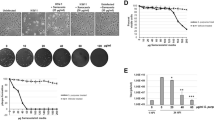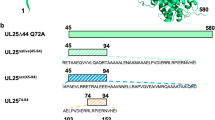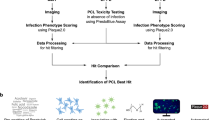Abstract
The vast majority of the world population is infected with at least one member of the human herpesvirus family. Herpes simplex virus (HSV) infections are the cause of cold sores and genital herpes as well as life-threatening or sight-impairing disease mainly in immunocompromized patients, pregnant women and newborns. Since the milestone development in the late 1970s of acyclovir (Zovirax), a nucleosidic inhibitor of the herpes DNA polymerase, no new non-nucleosidic anti-herpes drugs have been introduced. Here we report new inhibitors of the HSV helicase-primase with potent in vitro anti-herpes activity, a novel mechanism of action, a low resistance rate and superior efficacy against HSV in animal models. BAY 57-1293 (N-[5-(aminosulfonyl)-4-methyl-1,3-thiazol-2-yl]-N-methyl-2-[4- (2-pyridinyl)phenyl]acetamide), a well-tolerated member of this class of compounds, significantly reduces time to healing, prevents rebound of disease after cessation of treatment and, most importantly, reduces frequency and severity of recurrent disease. Thus, this class of drugs has significant potential for the treatment of HSV disease in humans, including those resistant to current medications.
This is a preview of subscription content, access via your institution
Access options
Subscribe to this journal
Receive 12 print issues and online access
$209.00 per year
only $17.42 per issue
Buy this article
- Purchase on Springer Link
- Instant access to full article PDF
Prices may be subject to local taxes which are calculated during checkout




Similar content being viewed by others
References
Knipe, D.M. & Howley, P.M. Fields Virology, 4th edn. 2399–2509 (Lippincott Williams Wilkins, Philadelphia, 2001).
Boehmer, P.E. & Lehmann I.R. Herpes simplex virus replication. Ann. Rev. Biochem. 66, 347–384 (1997).
Schaeffer, H.J. et al. 9-(2-Hydroxyethoxymethyl)guanine activity against viruses of the herpes group. Nature 272, 583–585 (1978).
Keating, M.R. Antiviral agents for non-human immunodeficiency virus infection. Mayo Clin. Proc. 74, 1266–1283 (1999).
Fischer, R. et al. Thiazole urea derivatives and their utilization as antiviral agents. Patent application WO-00/53591-A, PCT/EP01498 EP1161423 (2000).
Fischer, R. et al. Thiazole amide derivatives and their utilization as antiviral agents. Patent application WO-01/47904, PCT/EP01498 EP1161423 (2001).
O'Brien, J.J. & Campoli-Richards, D.M. Acyclovir—an updated review of its antiviral activity, pharmacokinetic properties and therapeutic efficacy. Drugs 37, 233–309 (1989).
Brown, S.M. & MacLean, A.R. Herpes Simplex Virus Protocols (Humana, Totowa, New Jersey, 1998).
Crumpacker, C.S., Schnipper, L.E., Zaia, J.A. & Levin M.J. Growth inhibition by acycloguanosine of herpesviruses isolated from human infections. Antimicrob. Agents Chemother. 15, 642–645 (1979).
Collins, P. & Darby G. Laboratory studies of herpes simplex virus strains resistant to acyclovir. Rev. Med. Virol. 1, 19–28 (1991).
Hall, M.C. & Matson, S.W. Helicase motifs: the engine that powers DNA unwinding. Mol. Microbiol. 34, 867–877 (1999).
Field, H.J., Anderson, J.R. & Efstathiou, S. A quantitative study of the effects of several different nucleoside analogues on established herpes encephalitis in mice. J. Gen. Virol. 65, 707–719 (1984).
de Clercq, E. & Luczac, M. Intranasal challenge of mice with herpes simplex virus: an experimental model for the evaluation of the efficacy of antiviral drugs. J. Inf. Dis. 133, A226–A236 (1976).
Simmons, A. & Nash, A.A. Zosteriform spread of herpes simplex virus as a model of recrudescence and its use to investigate the role of immune cells in prevention of recurrent disease. J. Virol. 52, 816–821 (1984).
Kern, E.R. & Glasgow L. Treatment of genital herpes simplex virus infections in guinea pigs. in Herpesvirus, Proceedings of a Burroughs Wellcome–UCLA Symposium (ed. Rapp, F.) 617–636 (Alan R. Liss Inc., New York, 1984).
Spector, F.C., Liang, L., Giordano, H., Sivaraja, M. & Peterson, M.G. Inhibition of herpes simplex virus replication by a 2-amino thiazole via interactions with the helicase component of the UL5-UL8-UL52 complex. J. Virol. 74, 6979–6987 (1998).
Acknowledgements
We thank J. Blümel for clinical field isolates (UB1-31, UB33-47 & UB49-56) of HSV-1 and HSV-2; P. Spear and L. Kwan for analyzing herpesvirus entry into cells; P. Schaeffer for ICP-4 plasmids; S. Weller for recombinant baculoviruses; H.R. Hehnen for material and lab space to carry out the animal virus experiments (equine, porcine and bovine herpes strains).; M. Becka for statistical analysis of data; and K. Ostertag-Palm, M. Hucke, C. Stamm, E. Clemente, M. Werth, J. Wann, I. Hulsmann, S. Schaab, S. Vogel, S. Veldhoen, D. Ganzer, G. Köppe, J. Hotho, J. Leske, U. Zuther, H. Schoop, O. Augustin, M. Peters, J. Dornieden, H. Blum, E. Lindner, G. Heckmann, E. Carrozzo, B. Schulz, H. Küper, U. Reimann, M. Heidtmann, D. Höpker, A. Haas, A. Rudek, J. Daheim, J. Verlage, B. Poschmann, M. Heine and P. Hartmann for technical assistance.
Author information
Authors and Affiliations
Corresponding author
Rights and permissions
About this article
Cite this article
Kleymann, G., Fischer, R., Betz, U. et al. New helicase-primase inhibitors as drug candidates for the treatment of herpes simplex disease. Nat Med 8, 392–398 (2002). https://doi.org/10.1038/nm0402-392
Received:
Accepted:
Issue Date:
DOI: https://doi.org/10.1038/nm0402-392
This article is cited by
-
Targeting SARS-CoV-2 non-structural protein 13 via helicase-inhibitor-repurposing and non-structural protein 16 through pharmacophore-based screening
Molecular Diversity (2023)
-
Targeting herpes simplex virus with CRISPR–Cas9 cures herpetic stromal keratitis in mice
Nature Biotechnology (2021)
-
A high ATP concentration enhances the cooperative translocation of the SARS coronavirus helicase nsP13 in the unwinding of duplex RNA
Scientific Reports (2020)
-
Inhibition of Epstein-Barr virus reactivation by the flavonoid apigenin
Journal of Biomedical Science (2017)
-
The Influence of Hepatic and Renal Impairment on the Pharmacokinetics of a Treatment for Herpes Zoster, Amenamevir (ASP2151): Phase 1, Open-Label, Single-Dose, Parallel-Group Studies
Advances in Therapy (2017)



